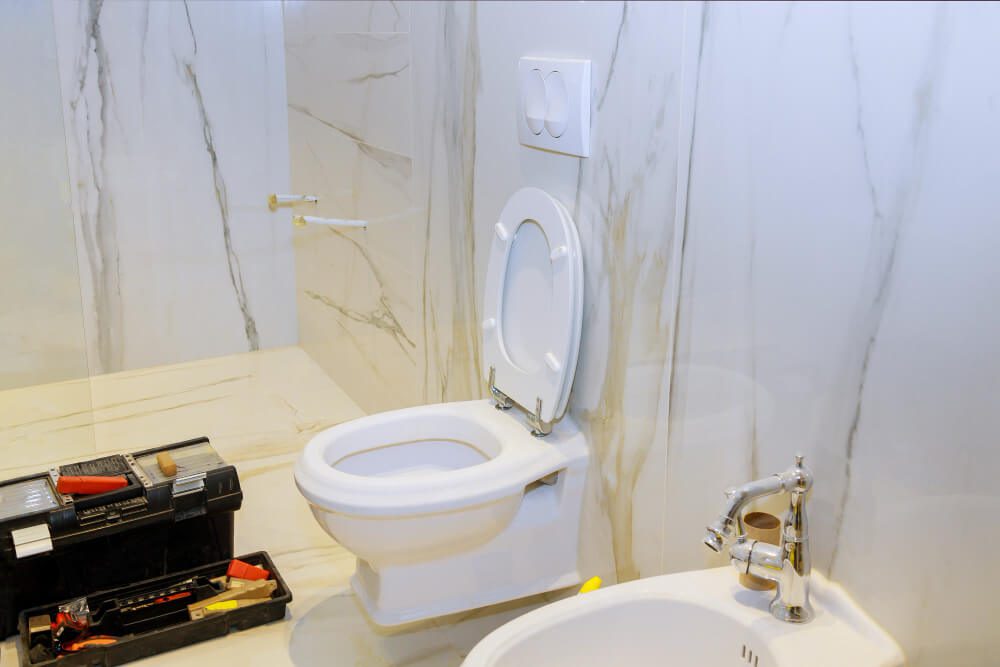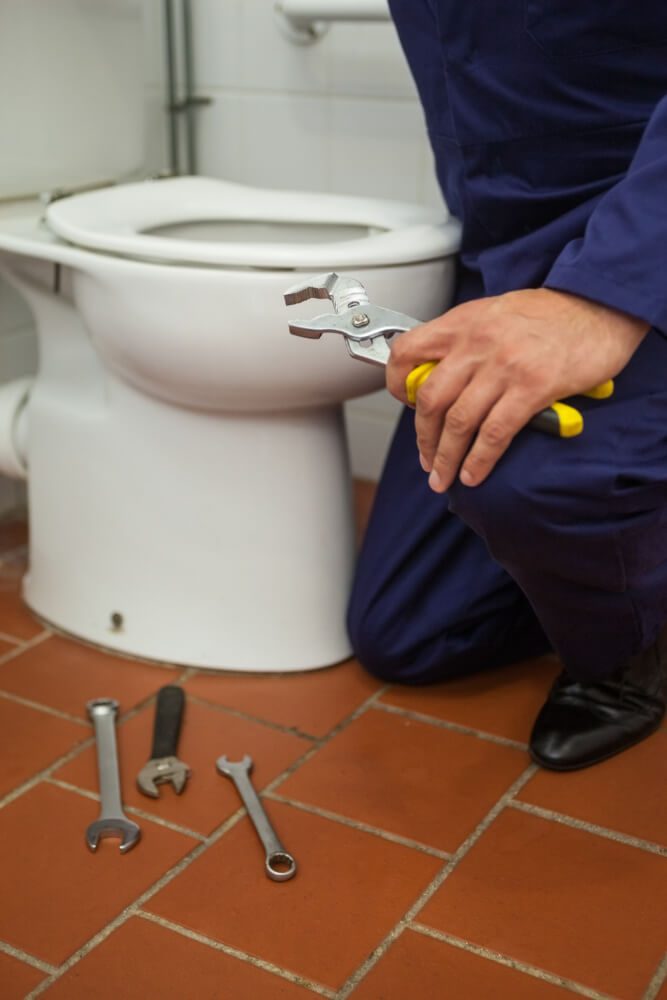Top blog articles
Looking to remodel your bathroom? One of the most dramatic changes you can make is to move the toilet. While it sounds like a daunting project, changing the toilet’s position can greatly improve your bathroom’s layout and functionality. But it raises a lot of questions: how to relocate a toilet, and should you even move it? If so, how far? And how much does it cost?
In this comprehensive guide, we’ll break down everything you need to know about relocating a toilet, including tips on adjusting drain lines, understanding plumbing codes, and what to consider before you start breaking through tiles.
Can You Actually Move a Toilet?
Yes, you absolutely can move a toilet. But how far and how easily you can move it depends on your current plumbing setup.
For small adjustments (say, a couple of inches), you might not even need to drill a new hole in the floor. In these cases, an offset toilet flange can do the trick. An offset flange lets you shift the toilet slightly in any direction without completely rerouting the plumbing. According to plumbing manufacturers, offset flanges can adjust a toilet’s position by approximately one to two inches laterally, making them ideal for minor layout tweaks. It’s a cost-effective solution if you’re just trying to tweak the bathroom layout.
However, if you’re planning to move the toilet more significantly (say, to the other side of the bathroom or even to a different room) you’re in for a much bigger project that involves new toilet drain lines, floor work, and possibly changing the vent and water supply.
What is an Offset Toilet Flange?
Unlike standard flanges that center directly over the waste pipe, an offset flange is off-center by design. This innovative component features an extended neck that provides flexibility in toilet placement without major plumbing overhauls.
When to use an offset flange:
- The existing drain is 1-2 inches off from your desired toilet location
- You’re replacing a 14-inch rough-in toilet with the more common 12-inch model
- Structural obstacles like floor joists prevent ideal drain placement
- You want to avoid expensive floor demolition and pipe rerouting
Installation of an offset flange typically takes 2-4 hours and requires basic plumbing tools. However, keep in mind that offset flanges should be considered a practical solution when traditional plumbing alignment isn’t feasible, as they can sometimes create sealing challenges if not installed properly.
How Far Can You Move a Toilet?
Theoretically, you can move a toilet as far as you want, even to another floor. But the further you move it from the main stack (the vertical pipe that connects to your home’s sewer system), the more complex (and expensive) the job becomes.
Here’s a good rule of thumb based on the drain line size:
- 3-inch diameter pipe: You can move the toilet up to 6 feet from the stack
- 4-inch diameter pipe: You may be able to go as far as 10 feet
Any move beyond these distances will likely require a new waste line with an appropriate slope. This is essential to prevent toilet sewage smells and ensure everything flushes as it should.
What About Cast Iron Pipes?
If your existing plumbing uses cast iron pipes, relocating a toilet gets trickier. Cast iron is durable but notoriously difficult to cut and modify. You’ll probably need a professional plumber with specialized tools and experience. Working with cast iron can also increase your costs by 30-40%, so budget accordingly.
What Does It Cost to Move a Toilet?

Moving a toilet isn’t a budget DIY project. Here’s what you can expect to spend:
- Basic relocation (minor adjustments with offset flange): $500–$1,500
- Moderate relocation (new drain line, no major structural changes): $2,500–$3,500
- Full relocation (new water supply, venting, and extensive floor plumbing): $4,000–$6,000
- With cast iron pipe modifications: Add 30%–40% more to any estimate above
These cost estimates can vary depending on labor costs in your area and the complexity of the project. If you’re doing a full bathroom remodel, it might make sense to include the toilet move as part of the bigger picture.
Pro tip: Use a bathroom remodeling cost estimator to get a more accurate picture of what your dream bathroom will cost, including relocating fixtures like your toilet.
Key Factors to Consider Before Moving a Toilet
Before you tear into your tile, here are some essential components to plan for:
Toilet Drainage and Slope Requirements
The toilet drain must connect to the main sewer stack at the right slope to function properly. According to building codes and plumbing standards documented by UpCodes, horizontal drainage piping requires specific minimum slopes based on pipe diameter:
- 1¼-inch to 2-inch pipes: Minimum slope of ¼ inch per foot
- 3-inch to 6-inch pipes: Minimum slope of ⅛ inch per foot
- 8-inch and larger pipes: Minimum slope of 1/16 inch per foot
For residential toilet installations with 3-inch or 4-inch drain pipes, the standard requirement is typically ¼ inch of slope per foot of horizontal run. This translates to a drop of 3 inches over a 12-foot distance.
Why proper slope matters: Too steep a slope causes water to flow faster than solids, potentially leaving waste behind and creating clogs. Too shallow a slope prevents proper drainage, leading to standing water, blockages, and unpleasant odors. Getting this slope right is critical to avoid future plumbing headaches.
Tip: If you’re unsure how to adjust the slope correctly, consult a licensed plumber. Gravity-based drainage systems must be installed with precision to meet local building codes and function reliably for years to come.
Vent Pipes
Vent pipes prevent a vacuum in your plumbing system, ensuring your toilet flushes smoothly and quietly. When relocating a toilet, you must also realign the vent pipe to match the new toilet flange and drain lines.
Every toilet requires proper venting to maintain atmospheric pressure in the drain system. Without adequate venting, you may experience:
- Slow, gurgling drains
- Incomplete flushes
- Sewer gas odors are entering your home
- Potential siphoning of water from other fixture traps
Skipping this step or improper vent installation can lead to sluggish flushing and (you guessed it) toilet sewage smells.
Water Supply Lines
The water line that feeds your toilet will need to be rerouted. This is usually easier than drain line modifications, but it must still be properly sealed to prevent leaks. Modern flexible supply lines make this connection relatively straightforward, but the rough-in plumbing behind the wall may need significant work.
Important: Don’t forget to shut off the water at the main valve and drain the pipes before beginning any work. Also, check your local codes, some jurisdictions require shut-off valves at each fixture.
Flooring and Structural Access
If your bathroom is on the second floor or above, relocating a toilet means accessing the subfloor and possibly cutting through floor joists or opening up the ceiling below.
Some considerations:
- Cutting joists may weaken the structure. Always consult a structural engineer or experienced contractor before cutting any load-bearing members
- Concrete slab floors require jackhammering, which is messy, noisy, and labor-intensive work that significantly increases project costs
- You’ll need to patch the flooring and possibly re-tile, factor in the cost of matching existing tile or installing new flooring throughout
For homes built on concrete slabs, you may want to consider alternative solutions like macerating toilet systems rather than breaking through concrete.
Do You Need a Permit to Move a Toilet?
In most cities, yes. Because moving a toilet involves plumbing work and can affect your home’s drainage system, a building permit is typically required. Inspections ensure that the plumbing meets code and there are no issues down the line.
Building permits for bathroom plumbing modifications generally cost between $50 and $200, depending on your location and the scope of work. The permit process typically includes:
- Initial plan review
- Rough-in inspection (before walls are closed)
- Final inspection (after project completion)
It’s best to check with your local building authority to confirm specific requirements before starting your project. Working without required permits can result in fines and complications when selling your home.
Can You Move a Toilet Yourself?
If you’re experienced in plumbing and construction, a minor toilet relocation using an offset flange might be manageable as a DIY project. However, anything that involves moving drain lines, cutting into the floor, or working with vent pipes is best left to professionals.
DIY considerations:
- Do you have experience with PVC or ABS pipe connections?
- Can you calculate and install the correct drain slope?
- Do you understand local plumbing codes?
- Are you comfortable working in confined spaces under floors?
Hiring a licensed plumber ensures that your bathroom project is done correctly, safely, and up to code. Professional installation also typically includes warranty coverage and peace of mind that inspections will pass.
Alternative Solutions to Traditional Toilet Relocation
If the cost or complexity of moving the toilet seems overwhelming, here are several workarounds that might better suit your situation:
1. Use an Offset Flange
As mentioned earlier, an offset flange can shift the toilet 1-2 inches in any direction without extensive plumbing work. This simple solution costs between $15 and $50 for the part, plus 2-4 hours of labor if hiring a professional.
2. Redesign the Bathroom Layout
Sometimes the best solution is working with what you have. Consider redesigning your bathroom layout around the existing toilet location. Modern space-saving fixtures and clever design can often achieve your goals without moving major plumbing.
3. Install an Upflush Toilet System
A macerating toilet (also called an upflush toilet) offers a revolutionary alternative to traditional gravity-fed toilets. These systems feature a built-in macerator pump that grinds waste into a fine slurry and pumps it through small-diameter pipes—even upward against gravity.
Key advantages of macerating toilets:
- Can be installed below the main sewer line (perfect for basements)
- Use 1-inch to 1.5-inch discharge pipes instead of 3-4 inch drain pipes
- Don’t require breaking through concrete floors
- Can pump waste up to 15 feet vertically and 150 feet horizontally
- Installation typically takes 6-8 hours versus days for traditional plumbing
According to Today’s Homeowner, upflush toilets are ideal for spaces without direct plumbing access, including basements, garages, attics, and even remote cabins. They only need a water supply, electrical connection, and access to a plumbing stack.
Cost considerations: Macerating toilet systems typically cost between $700 and $1,300, which is often less expensive than extensive traditional plumbing work. Installation is simpler because they don’t require major floor demolition or complex drain line modifications.
Important notes about macerating toilets:
- They require a dedicated electrical circuit (typically 15-amp)
- Most models need venting to your home’s vent system (check local codes)
- They’re quieter than older models (35-45 decibels)
- Designed for light to moderate use
- Cannot handle items like feminine hygiene products or paper towels
These systems are particularly popular for adding bathrooms to basements, creating guest bathrooms, or installing facilities in garage conversions where traditional plumbing would be prohibitively expensive.
Step-by-Step: How to Relocate a Toilet (Professional Overview)

While we strongly recommend hiring a licensed plumber for this work, here’s what the professional process typically involves:
1. Planning and Measurement
- Measure from the desired toilet location to the main stack
- Calculate required slope (typically ¼ inch per foot)
- Verify adequate space for new drain routing
- Check for obstacles (joists, utilities, ductwork)
- Secure necessary permits
2. Preparation
- Shut off the water supply
- Remove the existing toilet
- Cap or remove the old flange and drain connection
- Protect the area with drop cloths
3. Demolition
- Cut away the flooring to access the drain pipes
- Remove sections of subfloor as needed
- Open the ceiling below if the bathroom is on the upper floor
4. New Drain Installation
- Install a new drain pipe from the desired toilet location to the main stack
- Ensure proper slope throughout the run
- Use appropriate fittings (45° or 90° elbows as needed)
- Support pipes properly with hangers
5. Vent and Water Line Work
- Extend or relocate the vent pipe to the new toilet location
- Run a new water supply line
- Install a shut-off valve
6. Flange Installation
- Install a new toilet flange at the correct height (typically flush with the finished floor)
- Secure the flange to the subfloor or concrete
- Ensure flange is level
7. Flooring Repair
- Patch subfloor
- Install or repair finished flooring
- Match existing tile or flooring material
8. Toilet Installation
- Set the wax ring on the flange
- Position and secure the toilet
- Connect the water supply
- Test for leaks and proper operation
9. Final Inspection
- Schedule an inspection with the local building department
- Address any issues identified
- Obtain final approval
Common Mistakes to Avoid When Relocating a Toilet
Even experienced DIYers can run into problems. Here are the most common mistakes:
Incorrect Slope
The number one cause of drainage problems is improper slope. Too little slope causes standing water and clogs; too much slope causes solids to separate from liquids. Always double-check slope calculations and use a level during installation.
Inadequate Venting
Failing to properly vent the new toilet location results in slow drains, gurgling sounds, and sewer gas infiltration. Every toilet must have adequate venting according to code.
Cutting Structural Members
Never cut floor joists or other structural members without consulting a structural engineer. Improper structural modifications can compromise your home’s safety.
Using Incompatible Materials
Mixing different pipe materials (PVC, ABS, cast iron) requires proper transition fittings. Using incorrect connectors can lead to leaks and code violations.
Skipping the Permit Process
Unpermitted work can result in fines, insurance claim denials, and complications during home sales. Always obtain required permits.
Improper Flange Height
The toilet flange should sit on top of the finished floor, not below it. A flange that’s too low creates leak paths and unreliable sealing.
How Long Does It Take to Relocate a Toilet?
Project timelines vary significantly based on complexity:
- Offset flange installation: 2-4 hours
- Simple relocation (same room, easy access): 1-2 days
- Moderate relocation (same floor, structural access needed): 3-5 days
- Complex relocation (different floor, extensive rerouting): 1-2 weeks
These timelines include proper curing time for concrete patches, adhesives, and other materials that can’t be rushed.
Toilet Relocation Checklist
Before starting your project, ensure you have:
Planning Phase:
- ☐ Measured new location and verified feasibility
- ☐ Calculated required drain slope
- ☐ Checked local building codes
- ☐ Obtained necessary permits
- ☐ Hired licensed plumber (if not DIY)
- ☐ Scheduled utility markings (if applicable)
Materials Needed:
- ☐ New toilet flange (standard or offset)
- ☐ PVC or ABS pipe and fittings
- ☐ Wax ring(s)
- ☐ Toilet bolts
- ☐ Water supply line
- ☐ Shut-off valve
- ☐ PVC primer and cement
- ☐ Flooring repair materials
- ☐ Caulk
Tools Required:
- ☐ Reciprocating saw or jigsaw
- ☐ Pipe cutter or hacksaw
- ☐ Level (2-foot and 4-foot)
- ☐ Tape measure
- ☐ Drill with hole saw bits
- ☐ Wrench set
- ☐ Screwdriver set
- ☐ Bucket and rags
When Moving a Toilet Makes Sense (And When It Doesn’t)

Consider relocating your toilet when:
- You’re doing a complete bathroom renovation
- The current location creates poor traffic flow
- You’re converting a tub to a shower and need more space
- You’re adding a double vanity, and the toilet location conflicts
- Building codes require changes for accessibility
- You’re expanding the bathroom into the adjacent space
Think twice about relocating when:
- Your budget is tight (explore alternatives first)
- The toilet currently works well in its location
- Minor adjustments with an offset flange would suffice
- Your home has concrete slab floors (very expensive)
- You have cast iron pipes (30-40% cost increase)
- The move would be more than 10 feet from the main stack
How Toilet Relocation Impacts Home Value
Properly executed bathroom renovations typically return 60-70% of their cost in increased home value. However, the return depends on:
- Overall quality of the finished bathroom
- Whether the relocation improved functionality and flow
- Compliance with building codes
- Professional installation quality
- Updated fixtures and finishes
A poorly executed toilet relocation that creates drainage problems or code violations can actually decrease home value and complicate sales. This is why professional installation with proper permits is so important.
Frequently Asked Questions About Moving Toilets
Q: Can I move my toilet a few feet over without a permit? A: Most jurisdictions require permits for any work that involves changing drain lines or altering plumbing systems. Check with your local building department; working without required permits can cause problems later.
Q: What’s the best way to match existing tile after moving a toilet? A: Take a tile sample to flooring stores to find the closest match. If you can’t match it exactly, consider creating a decorative border or pattern that incorporates both old and new tiles intentionally.
Q: Can I move a toilet to an exterior wall? A: Yes, but you’ll need to ensure proper pipe insulation to prevent freezing in cold climates. Vent pipes on exterior walls may also require special considerations.
Q: How do I know if my floor joists can handle cutting? A: Consult a structural engineer before cutting any floor joists. Some cuts can be made safely with proper reinforcement, but this should never be a DIY decision.
Q: Is it easier to move a toilet on the first floor or the second floor? A: First-floor relocations are typically easier because you have access from the basement or crawl space below. Second-floor moves require opening the ceiling below, making them more complex and expensive.
Final Thoughts
Relocating a toilet can completely transform your bathroom’s layout, making it more functional and visually appealing. However, it’s a complex project with many moving parts, drain lines, vent pipes, the toilet flange, water supply, and floor structure, all come into play.
Before starting, ask yourself: Is the layout change worth the cost and complexity?
If the answer is yes, proper planning makes all the difference. Make sure you:
- Plan carefully and understand all requirements
- Hire the right professionals with plumbing experience
- Secure necessary permits and schedule inspections
- Budget for unexpected issues (they almost always arise)
- Consider alternatives like offset flanges or macerating systems
A well-executed toilet relocation can add comfort, efficiency, and even value to your home. But remember: cutting corners on plumbing work almost always costs more in the long run through repairs, water damage, and code violations.
Take your time, do it right, and enjoy your newly configured bathroom for years to come!
Ready to start your bathroom renovation? Use our bathroom remodeling cost estimator to budget accurately and find qualified contractors near you to bring your vision to life.









